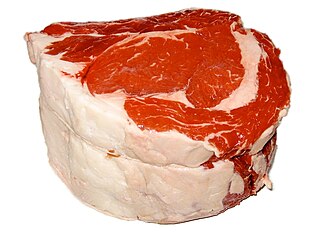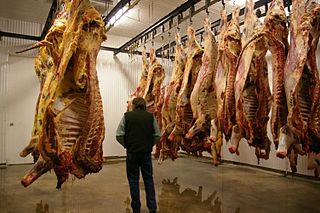Related Research Articles

Meat is animal flesh that is eaten as food. Humans have hunted and killed animals for meat since prehistoric times. The advent of civilization allowed the domestication of animals such as chickens, sheep, rabbits, pigs and cattle. This eventually led to their use in meat production on an industrial scale with the aid of slaughterhouses.

Beef is the culinary name for meat from cattle, particularly skeletal muscle. Humans have been eating beef since prehistoric times. Beef is a source of protein and nutrients.

Adenosine monophosphate deaminase deficiency type 1 or AMPD1, is a human metabolic disorder in which the body consistently lacks the enzyme AMP deaminase, in sufficent quantities. This may result in exercise intolerance, muscle pain and muscle cramping. The disease was formerly known as myoadenylate deaminase deficiency or MADD. While it is usually a recessive genetic disorder, there is also a rarer, acquired form of AMP deficiency.
Rigor mortis, or postmortem rigidity, is the third stage of death. It is one of the recognizable signs of death, characterized by stiffening of the limbs of the corpse caused by chemical changes in the muscles postmortem. In humans, rigor mortis can occur as soon as four hours after death.

Lactic acid fermentation is a metabolic process by which glucose or other six-carbon sugars are converted into cellular energy and the metabolite lactate, which is lactic acid in solution. It is an anaerobic fermentation reaction that occurs in some bacteria and animal cells, such as muscle cells.

Lactic acidosis is a medical condition characterized by the buildup of lactate in the body, with formation of an excessively low pH in the bloodstream. It is a form of metabolic acidosis, in which excessive acid accumulates due to a problem with the body's oxidative metabolism.
Weakness is a symptom of a number of different conditions. The causes are many and can be divided into conditions that have true or perceived muscle weakness. True muscle weakness is a primary symptom of a variety of skeletal muscle diseases, including muscular dystrophy and inflammatory myopathy. It occurs in neuromuscular junction disorders, such as myasthenia gravis.
Muscle fatigue is the decline in ability of a muscle to generate force. It can be a result of vigorous exercise but abnormal fatigue may be caused by barriers to or interference with the different stages of muscle contraction. There are two main causes of muscle fatigue: the limitations of a nerve’s ability to generate a sustained signal ; and the reduced ability of the muscle fiber to contract.

There are different systems of feeding cattle in animal husbandry, which may have different advantages and disadvantages. Most cattle in the US have a fodder that is composed of at least some forage. In fact, most beef cattle are raised on pasture from birth in the spring until autumn. For pastured animals, grass is usually the forage that composes the majority of their diet. Cattle reared in feedlots are fed hay supplemented with grain, soy and other ingredients in order to increase the energy density of the feed. The debate is whether cattle should be raised on fodder primarily composed of grass or a concentrate. The issue is complicated by the political interests and confusion between labels such as "free range", "organic", or "natural". Cattle raised on a primarily foraged diet are termed grass-fed or pasture-raised; for example meat or milk may be called grass-fed beef or pasture-raised dairy. The term "pasture-raised" can lead to confusion with the term "free range", which does not describe exactly what the animals eat.

The Cori cycle, named after its discoverers, Carl Ferdinand Cori and Gerty Cori, is a metabolic pathway in which lactate produced by anaerobic glycolysis in muscles is transported to the liver and converted to glucose, which then returns to the muscles and is cyclically metabolized back to lactate.
Glycogen storage disease type I is an inherited disease that results in the liver being unable to properly break down stored glycogen. This impairment disrupts the liver's ability to break down stored glycogen that is necessary to maintain adequate blood sugar levels. GSD I is divided into two main types, GSD Ia and GSD Ib, which differ in cause, presentation, and treatment. GSD Ia is caused by a deficiency in the enzyme glucose-6-phosphatase, while GSD Ib is caused a deficiency in the enzyme glucose-6-phosphate translocase. Since glycogenolysis is the principal metabolic mechanism by which the liver supplies glucose to the body during periods of fasting, both deficiencies cause severe low blood sugar and, over time, excess glycogen storage in the liver and the kidneys.
Equine exertional rhabdomyolysis is a syndrome that damages the muscle tissue in horses. It is usually due to overfeeding a horse carbohydrates and appears to have a genetic link.
Muscle weakness is a lack of muscle strength. The causes are many and can be divided into conditions that have either true or perceived muscle weakness. True muscle weakness is a primary symptom of a variety of skeletal muscle diseases, including muscular dystrophy and inflammatory myopathy. It occurs in neuromuscular junction disorders, such as myasthenia gravis. Muscle weakness can also be caused by low levels of potassium and other electrolytes within muscle cells. It can be temporary or long-lasting. The term myasthenia is from my- from Greek μυο meaning "muscle" + -asthenia ἀσθένεια meaning "weakness".

Sports nutrition is the study and practice of nutrition and diet with regards to improving anyone's athletic performance. Nutrition is an important part of many sports training regimens, being popular in strength sports and endurance sports. Sports nutrition focuses its studies on the type, as well as the quantity of fluids and food taken by an athlete. In addition, it deals with the consumption of nutrients such as vitamins, minerals, supplements and organic substances that include carbohydrates, proteins and fats.

Beef cattle are cattle raised for meat production. The meat of mature or almost mature cattle is mostly known as beef. In beef production there are three main stages: cow-calf operations, backgrounding, and feedlot operations. The production cycle of the animals start at cow-calf operations; this operation is designed specifically to breed cows for their offspring. From here the calves are backgrounded for a feedlot. Animals grown specifically for the feedlot are known as feeder cattle, the goal of these animals is fattening. Animals not grown for a feedlot are typically female and are commonly known as replacement heifers. While the principal use of beef cattle is meat production, other uses include leather, and beef by-products used in candy, shampoo, cosmetics, insulin and inhalers.

Ractopamine is an animal feed additive used to promote leanness and increase food conversion efficiency in livestock in some countries, but banned in others. Pharmacologically, it is a phenol-based TAAR1 agonist and β adrenoreceptor agonist that stimulates β1 and β2 adrenergic receptors. It is most commonly administered to animals for meat production as ractopamine hydrochloride. It is the active ingredient in products marketed in the US as Paylean for swine, Optaflexx for cattle, and Topmax for turkeys. It was developed by Elanco Animal Health, a division of Eli Lilly and Company.
Pale, Soft, Exudative meat, or PSE meat, describes a carcass quality condition known to occur in pork, beef, and poultry. It is characterized by an abnormal color, consistency, and water holding capacity, making the meat dry and unattractive to consumers. The condition is believed to be caused by abnormal muscle metabolism following slaughter, due to an altered rate of glycolysis and a low pH within the muscle fibers. A mutation point in the ryanodine receptor gene (RYR1) in pork, associated to stress levels prior to slaughter are known to increase the incidence of PSE meat. Although the term "soft" may look positive, it refers to raw meat. When cooked, there is higher cook loss and the final product is hard, not juicy.

Meat hanging is the culinary process of dry-aging meat to develop its flavor and tenderness.

Agriculture in Wales has in the past been a major part of the economy of Wales, a largely rural country that forms part of the United Kingdom. Wales is mountainous and has a mild, wet climate. This results in only a small proportion of the land area being suitable for arable cropping, but grass for the grazing of livestock is present in abundance. As a proportion of the national economy, the importance of agriculture has become much reduced; a high proportion of the population now live in the towns and cities in the south of the country and tourism has become an important form of income in the countryside and on the coast. Arable cropping is limited to the flatter parts and elsewhere dairying and livestock farming predominate.
The Brava or Race de Combat is a French breed of domestic cattle raised in the Camargue, the delta of the Rhône in southern France. It is bred specifically for bull-fighting, either Spanish-style or Portuguese-style. It is one of two cattle breeds raised in semi-feral conditions in the Camargue: the other is the Raço di Biòu or Camargue breed, which is not a fighting breed but is used in a bloodless bull-sport, the course camarguaise. The Brava derives from Iberian fighting cattle imported in the nineteenth century, and may also be known as the Espagnole Brava.
References
- ↑ "Dark cutting beef – the economic loss". New South Wales Government. Retrieved 22 October 2019.
- 1 2 Littler, Brett; House, Jeffrey (June 2001). "Dark cutting beef - what is it?". New South Wales Government. Retrieved 22 October 2019.
- ↑ McKinnon, Bill R. (March 1998). "Beef Quality Corner - "Dark Cutters" Livestock Update". Virginia Cooperative Extension.
- ↑ "Dark cutting beef - managing cattle to reduce DCB". New South Wales Government. Retrieved 22 October 2019.
| This meat-related article is a stub. You can help Wikipedia by expanding it. |